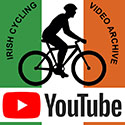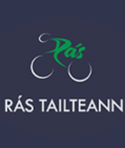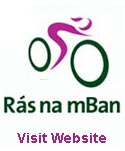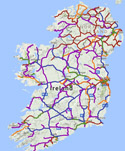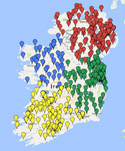As well as stretching, self-massage using foam rollers is another good way to work out tension and knots in muscles and can be carried out in conjunction with stretching. Foam rollers are cylinders of firm foam approximately 6 inches in diameter from 2 to 4 feet long, although new models in plastic form are also available. They work through using body weight to apply pressure on to the muscle. Body movement then helps to roll the foam-roller along the muscle which stretches and massages the muscle. They are widely available to buy on the internet e.g. Amazon.com, and some bike/sport shops from about €18
PART 1
In Part 1 I will show how to stretch key muscles in the legs. There are many different ways to stretch the same muscle and everyone will vary in their preference, if you have a method that suits you which is not described here continue with it.
To understand why your muscles tighten or get tired I will base the description of the muscle function on the pedal revolution. When your foot is on the pedal and the pedal is at the top you are in a position where your hip is flexed (thigh is closer to your chest) and your knee is flexed (bent). As you push down on the pedal your leg extends (your thigh moves away from your chest), and your knee starts to straighten – this involves the gluteus maximus, hamstring and quadriceps muscles. The calfs are also involved stabilising the foot throughout this movement As you bring the pedal back up to continue the rotation your thigh starts to come closer to your chest again and the knee starts to flex – this involves the hip flexors, the front of shin which gives stability, and the hamstrings.
General Stretching Guidelines
Make sure the body is warmed up prior to stretching. When performing stretches after training each stretch is held for 30 seconds and repeated 3 times on each limb unless otherwise indicated. A mild or moderate stretch should be felt. Stretching to the point of pain is not advised as this can tear and damage muscles. Where two stretches are described for a muscle, just do one of them, there is no need to do both.
When stretching prior to racing or a training spin each stretch is held for up to 10 seconds after warm up. For short fast races e.g. track or time trials, when fractions of a second are important it may be better to focus on a good warm up rather than static stretching as some studies have suggested that static stretching immediately prior to an event may reduce muscle performance by fractions of a second.
General Foam Rolling Guidelines
1. When using foam rollers spend about a minute 2-3 times a week on the muscle being worked out. It can feel tender on tired or very tight muscles so don’t overdo it at first; your tolerance will start to build over the weeks as you use the foam roller. If you have any concerns ask a Medical Professional.
2. The movments can be large i.e. one long roll along the whole muscle, small - where you roll back and forward over a tight area, or you can just focus on one tender spot and allow the pressure from your body weight gradually cause it to release out.
3. For muscles on the front and back of the legs, you can roll both legs at the same time or do one at a time
Note; if you are injured or have an existing muscle or joint problem get medical advice before undertaking these exercises.
Quadriceps
The quadriceps are made up of four muscles at the front of the thigh. These muscles are responsible for straightening the knee, and are particularly active during the first 90° of the down stroke (0° being when the pedal is top dead centre, and 180° when the pedal is bottom dead centre). One of the four muscles also assists with hip flexion i.e. bringing the thigh closer to the chest on the upstroke. The quads are generally the area where cyclists most commonly report fatigue or delayed onset muscle soreness (DOMS) after training or racing. Supple quads are important to prevent tendonitis just under the kneecap.
Quadriceps Stretch – Lying Down with a Towel
For those with reduced flexibility in their back this stretch with the towel might be more suitable.
1. Lie on a firm surface face down
2. Bend the knee up and place a towel around the ankle
3. Grasp the towel by the two ends
4. Bend the knee and pull it using the towel towards the buttocks until a mild stretch is felt in the front of the thigh
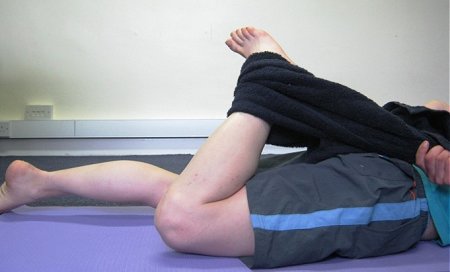
|
Quadriceps Stretch - Standing
1. Stand on a stable surface near a wall or stable structure which you can hold on to for support if necessary
2. Bend the knee of the thigh to be stretched and grasp the foot with the hand
5. Bring the foot towards the buttocks until a mild stretch is felt in the front of the thigh
Note: aim to get the knee pointing to the ground; if your quads are tight you may not be able to achieve this at first.
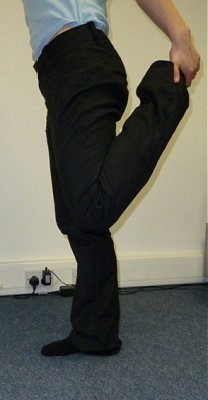
|
Foam Rolling for the Quadriceps
1. Place the foam roller on a firm surface
2. Lie face down over the foam roller putting the roller under the front of the thighs
3. Use your arms to push and pull your body over the foam roller from the top of the thigh down to the knee
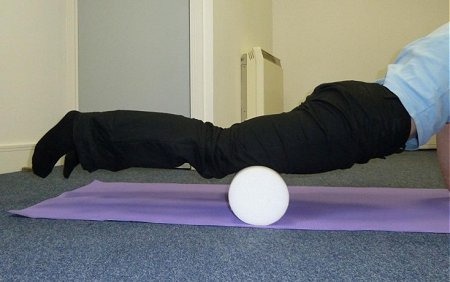
|
Hamstrings & Gluteus Maximus
The hamstrings (there are three of them) are located at the back of the thigh. They play a role in carrying out downstroke in cycling by working with the gluteus maximus to extend the leg. They also are active in the upstroke by helping to bend the knee as the leg comes back up. The gluteus maximus is the largest muscle in the gluteal area and is a very strong leg extender. It peaks during the first half of the down stroke as the thigh is brought away from the chest, and is very active when cycling out of the saddle as this creates more demand on it.
Hamstring Stretch – Lying Down
For those with reduced flexibility in their back the stretch with the towel might be more suitable.
1. Lie on a firm surface face up
2. Bend the knee up and place a towel around the arch of the foot
3. Grasp the towel by the two ends
4. Straighten out the leg
5. Using the towel draw the straightened leg towards the head until a mild stretch is felt in the back of the thigh
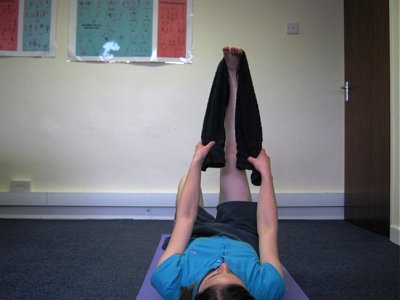
|
Gluteus Maximus and Hamstring stretch
1. Place the heel up on to a small step in front of the body
2. Keeping the leg as straight as is comfortable lean the body forward
3. A mild stretch should be felt in the back of the thigh (you may also feel a stretch into your calf)
4. Turn your foot to the left and right to target the different fibres of the hamstrings which you might feel as a stretch more to the inside or outside of the thigh depending on the position of your foot.
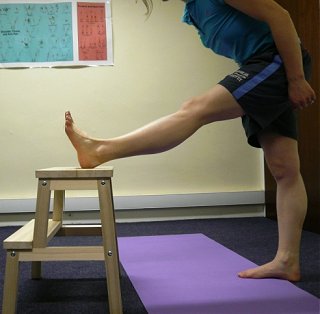
|
Foam Rolling for the Hamstrings & Gluteus Maximus
1. Place the foam roller on a firm surface
2. In a sitting position put the roller under the back of the thighs. Lean back onto your hands
3. Use your arms to push and pull your body over the foam roller from the top of the thigh down to the knee
4. To work your gluteus maximus sit on the roller with your legs outstretched and roll back and forward on it
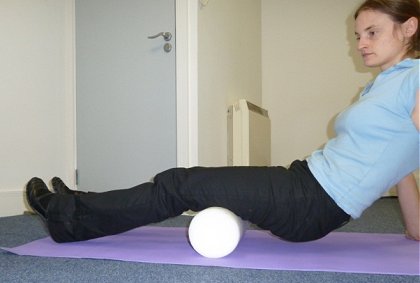
|
Hip Flexor
The hip flexors does what it says, flexes the hip bringing the thigh closer to the chest on the up stroke. They also play a role in creating and maintaining the flexed position cyclists adopt on the bike. Tight hip flexors can be a contributor to low back pain due to trigger points in these muscles referring into the lower back. The hip flexor is also assisted in its task by one of the quadriceps which helps it to flex the hip. In conjunction with tight quadriceps, the hip flexor can also change the posture of the pelvis causing it to tilt forward, creating a lordosis or dipping in of the lower back which can also lead to low back pain.
Stretch for hip flexors
The stretch should be felt at the front of the hip and down into the top the thigh.
1. Kneel on the knee of the side to be stretched. Put the other foot out in front of you
2. Lean the hips forward and bring the shoulders backwards
3. A stretch should be felt at the top of the thigh. Raise your arms over the head to get a better stretch if necessary. Rest your knee on a cushion should kneeling on one knee causes discomfort.
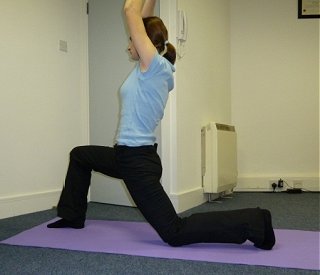
|
Calf
The two main muscles of the calf play a role as stabilisers by controlling the amount of movement at the ankle, and the transfer of power from the legs to the pedals. They are very active during the final stage of the down stroke as they raise the heel a little to concentrate the power through the top of the foot into the pedal. They can be forgotten about by cyclists when stretching as not many will complain of tired calfs. As both muscles are stretched in subtly different ways a stretch for each muscle will be described.
Stretching the Calf
1. Stand on the edge of a step
2. Keeping the knee straight drop the heel downwards. You should feel a stretch in the back of the knee
3. Repeat this with the knee slightly bent to target the other calf muscle
Foam Rolling for the Calf
1. Place the foam roller on a firm surface
2. Sit with legs outstretch and place the foam roller under the calf. Lean back on your hands
3. Use your arms to push and pull your body over the foam roller from the top of the knee down towards the heel
4. You can place one leg on top of the other to increase the body weight and downward pressure going into the foam roller.
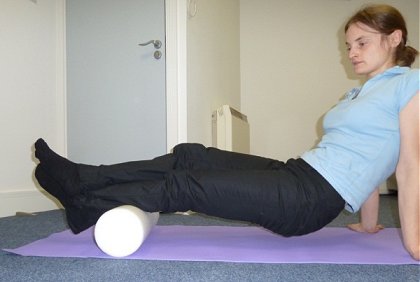
|
Piriformis/External Rotator Stretch
The external rotators are small muscles underneath the gluteal muscles. They rotate the hip outwards e.g. like when your knees point outwards when sitting in a chair. When they get tight, trigger points in these muscles can refer pain into gluteal area, and down into the back of the thigh. This can be aggravated during activities like sitting for extended periods, such as long drives where the right foot is held in an externally rotated position to use the accelerator. In some people the sciatic nerve passes through one of these small muscles (the piriformis), and if that muscle gets tight it can compress the nerve creating sciatic like pain down the back of the leg.
External Rotator Stretch – lying down version
See diagram for an indication where you may feel this stretch.
1. Lie on your back
2. Bend the right leg and draw the right knee on the side to be stretch towards the LEFT (i.e. opposite) shoulder
3. Additional stretch can be added by holding the right ankle and pulling it gently towards the head.
4. Repeat on the opposite side
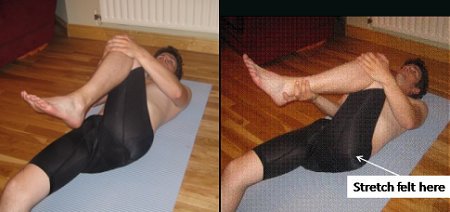
|
These muscles can also be stretched in a seated position but the lying down version is more useful for those who are flexible as not everyone can get into the seated position. Avoid the seated version if you have reduced mobility in your back or hip.
External Rotator Stretch - sitting version
1. Sit up straight on a chair with feet flat on the floor
2. Place the ankle of the side to be stretched on the opposite knee. A stretch may be felt in the gluteal region on doing this.
3. Lean the upper body forward to increase the stretch if needed.
4. Hold the stretch, then return to normal seated position.
5. Repeat on opposite leg
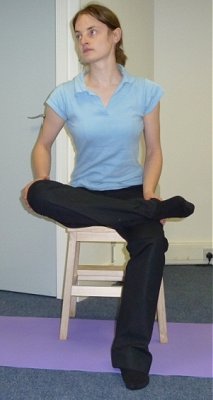
|
Foam Rolling for the Piriformis and Gluteals (one side at a time)
1. Place the foam roller on a firm surface
2. Lie face up over the foam roller putting the roller under the buttocks.
3. Rotate the body a little to the side to catch the side of the gluteals.
4. Use your arms to push and pull your body over the foam roller.
5. Alternatively: Lie on ground half on your side/half face up, and place a tennis ball under your buttocks. This can be more precise than a foam roller but a lot sorer. If this is the case place the tennis ball under a towel or wrap it in socks to make it tolerable. It can be less sore to stay still and allow the tightness to ease rather than moving over the tennis ball.
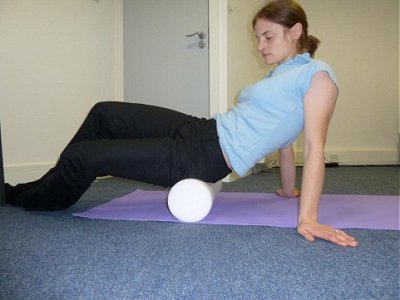
|
Iliotibial Band (ITB)
A tight ITB can cause iliotibial band friction syndrome leading to pain at the outside of the knee which can keep you off your bike for a few weeks. It plays a role in stabilising the pelvis when cycling, and weakness in other muscles such as your gluteals as well as factors such as your bike set up can lead to problems with the ITB. It is hard to stretch but I have included a stretch here for completeness. Cyclists often find that self-massage on a foam roller is the best way to keep it supple.
ITB Stretch
1. Stand with one foot in front of the other with a firm surface that can be used for support on the right e.g. table or chair
2. Holding on to the support, bring the leg to be stretched behind and back across front leg as per diagram.
3. Bring it out to the side until a stretch can be felt on the outside of the back leg
4. Try to keep the trunk in an upright position.
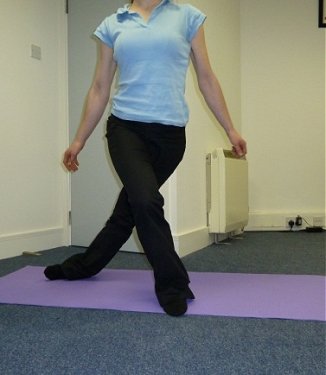
|
Foam Rolling for the ITB
1. Place the foam roller on a firm surface
2. Lie on your side placing the foam roller under the lower thigh
3. This can be quiet tender so work slowly
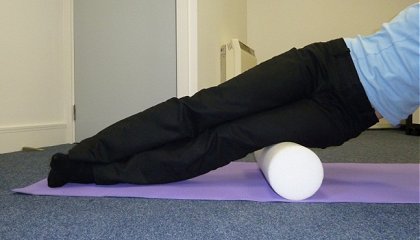
|
Adductors and Hip
The adductors are muscles on the inside of the thigh that hold the knees inwards when cycling. The stretch below stretches these muscles and also helps to stretch out the hip joint itself.
Adductor stretch
1. Sit on the floor and adopt the position as per the picture below. The tighter you adductors and hips the more your knees will point towards the sky.
2. Lean forward until a mild stretch is felt on the inside of the thighs. You might also feel this stretch in your gluteals.
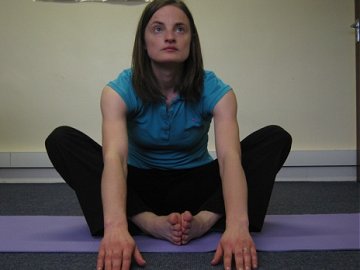
|
